R_Volution PlayerOne 8K Dolby Vision MultiMedia Center – HDR10+ Ultimate Video Experience
R_Volution PlayerOne 8K is a $899 USD high-end media player, compatible with both Dolby Vision and HDR10+, capable of streaming content to other R_Volution devices in a network and internal hard drive bays, for storing your favorite TV Shows, Movies and live concerts. R_Volution PlayerOne 8K is also compatible with the latest AV1 Codec, and it supports resolutions up to 8K and delivers a stunning picture and sound quality, to meet the highest demand of home theater enthusiasts. Today we will review the PlayerOne 8K, and as I’m a huge movie and HT aficionado, I will explore the differences, pros and cons of using a media player versus a dedicated Personal Computer.
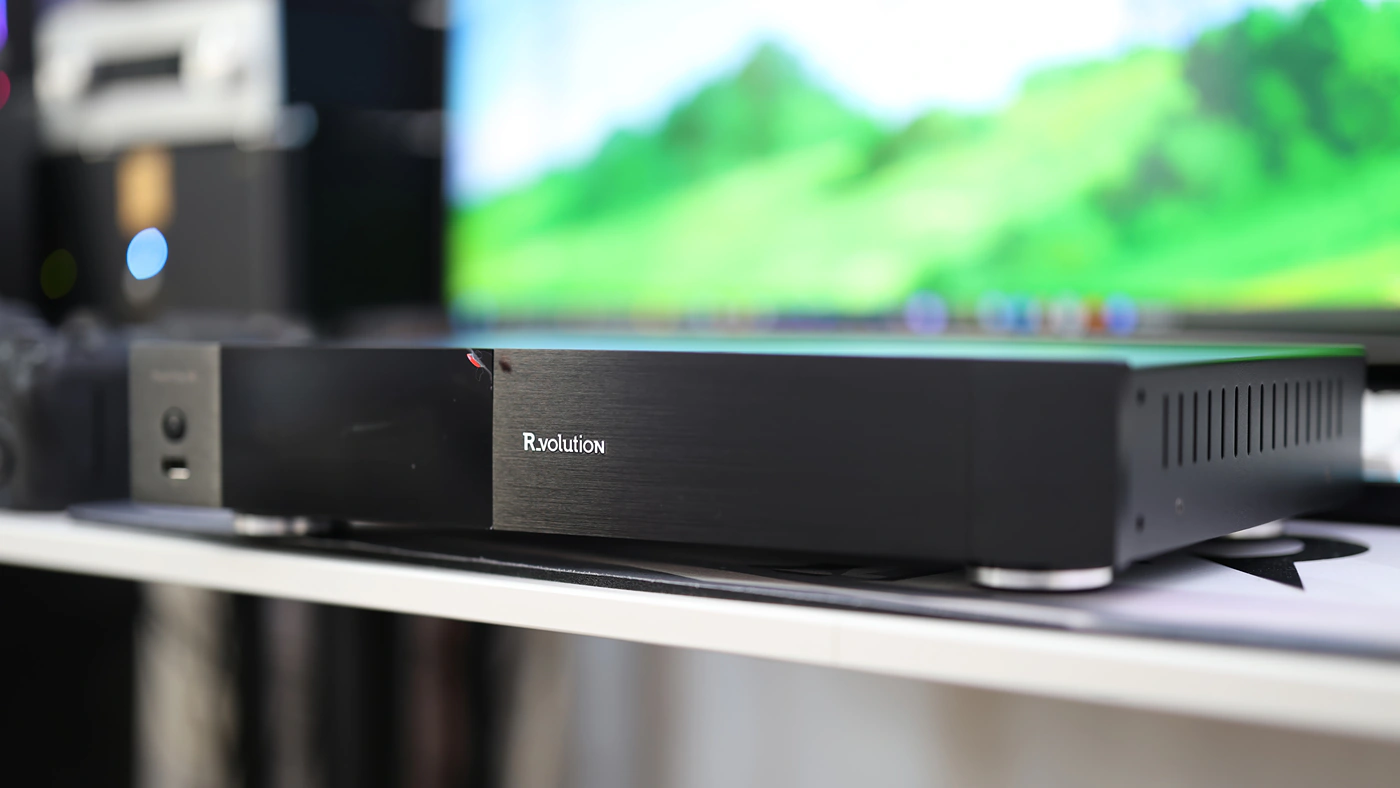
Introduction
While this is our first review exploring a high-end multimedia player I surely hope it is the first of many, as I’ve always been a huge horror movie, comedy and anime fan, and have watched countless shows, image quality has always been one of my main concerns when it comes to my multimedia experiences. I even made a handy guide in the past to using madVR and MPC-HC, together with multiple other interpolation filters and real time image processing algorithms to watch movies and videos in better quality, but R_Volution takes this one step further, creating what I’d consider to be the most advantaged media player ever designed that I tested. This is not a CD or DVD player, it is a multimedia processor that can playback the highest resolution / quality files, and has support for 8K resolutions, Dolby Vision, Dolby Atmos, Auro 3D and dtsX, even HDR10+. As an Amazon Influencer, I earn from qualifying purchases, and using the purchase links in my reviews helps me maintain this website and Youtube Channel. Huge thanks to R_Volution for providing us with the sample for this review.
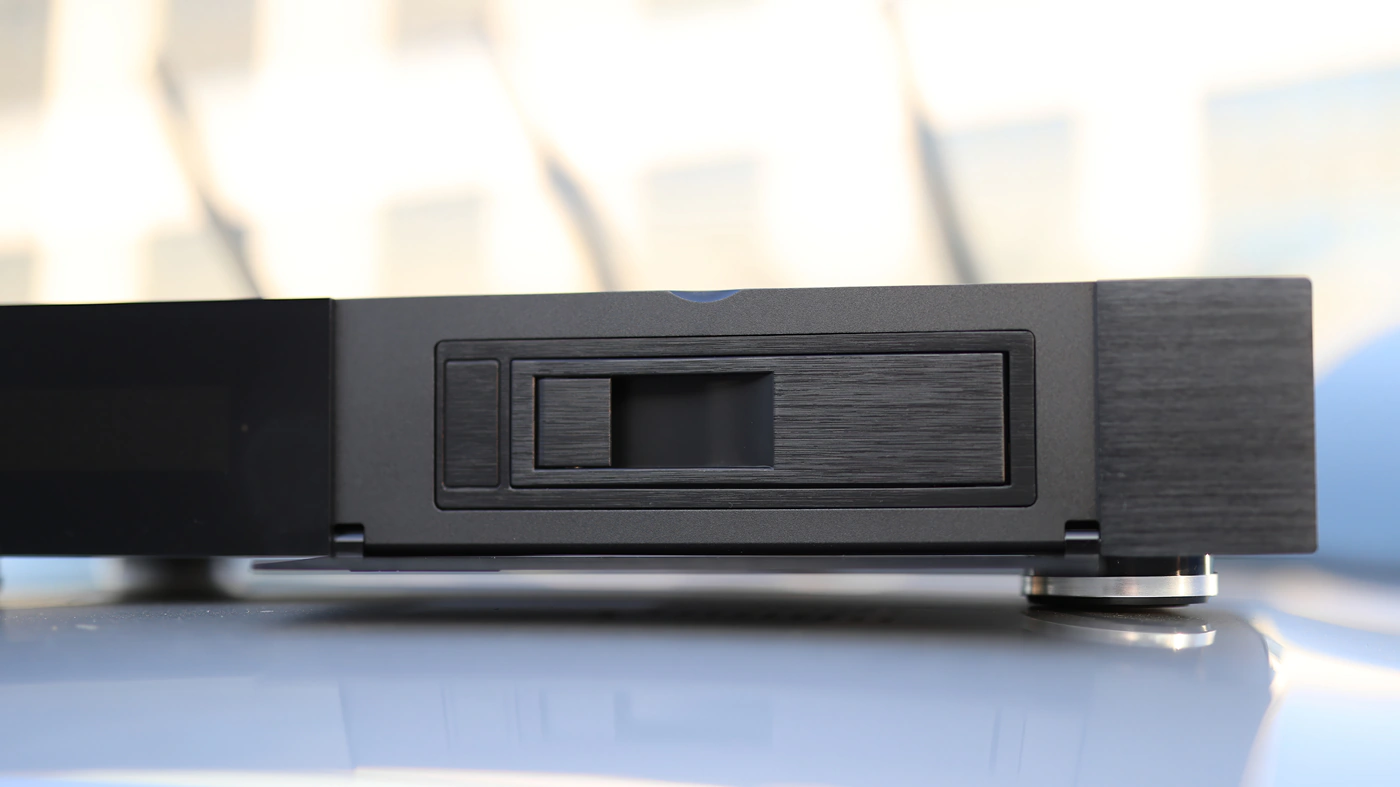
PROs – Superb software that is fast, reliable and offers playback support for all file types, including high resolution 4K 120 fps videos. Colorful, vivid and punchy image with high depth and excellent contrast, plus high detail revealing ability, without smothering micro details. Some of the best images you will ever see on a media player and from your TV.
Cons – Large and takes quite a bit of space. Takes some time getting used to.
Product Link
Official Link – https://rvolution.store/en/media-players/6272-rvolution-player-one-8k.html
Amazon – https://amzn.to/4eVnNeP
Build Quality/Aesthetics
To address the biggest question in the room, I have no idea why the company went for the R_Volution name and did not just use Revolution, as that’s the implementation, but it is likely because Revolution is too common of a name, and R_Volution just looks cooler. The PlayerOne 8K is technically one of the most advanced media players that exists, having full support for 8K Ultra HD Resolution, along with easy and intuitive access to one’s entire movie library. To leverage some of the library organization effort, PlayerOne 8K uses the most advanced AI algorithms available to customize one’s movie library, and allows you to create custom groups and categories, listen to the original soundtrack while browsing titles and personalize your homepage to upload your own content, covers and backgrounds.
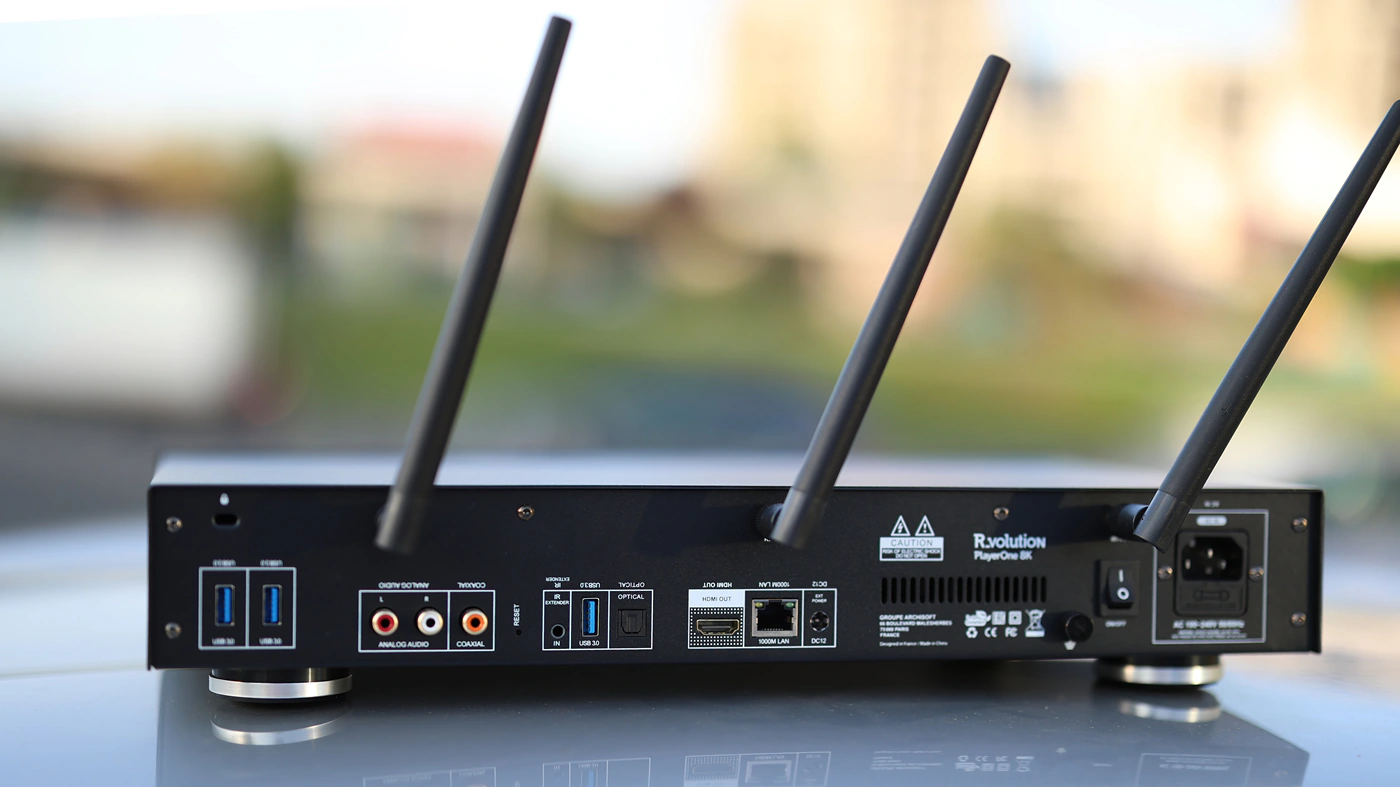
While PlayerOne 8K supports the vast majority of digital audio and video formats, the highlight is that it supports HDR, including Dolby Vision and HDR10+, both of which my computer still struggles with, and and we have support for MKVs, BD and UHD ISO files, with AV1 and HEVC video codecs being supported, and through the full-speed HDMI 2.1 port, you can output 8K 60p HDR signals, and high-resolution audio files including DFD, AIFF, FLAC and ALAC, with extended support for AURO3D, Dolby Atmos and DTS:X for the best possible home theater experience.
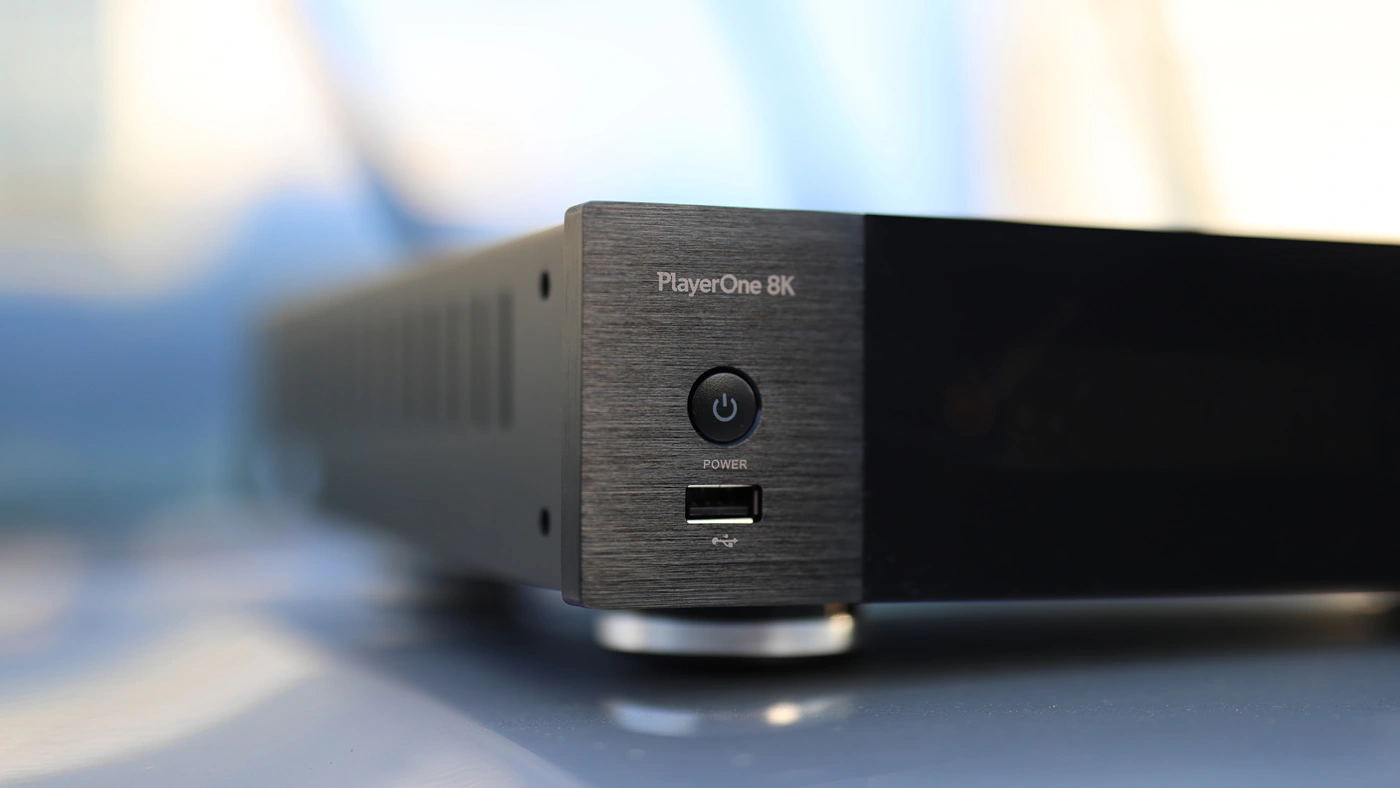
Just recently we’ve started seeing an influx of HDMI Arc supported DACs, and this will be one of the things we will be testing with the PlayerOne 8K. There’s plenty of hardware support for the claims of the R-Volution company, and PlayerOne 8K uses a S928X Chipset, the same as most flagship media player devices, with an A55 + A76 processor, with 8 GB of RAM and 64 GB of EMMC Memory.
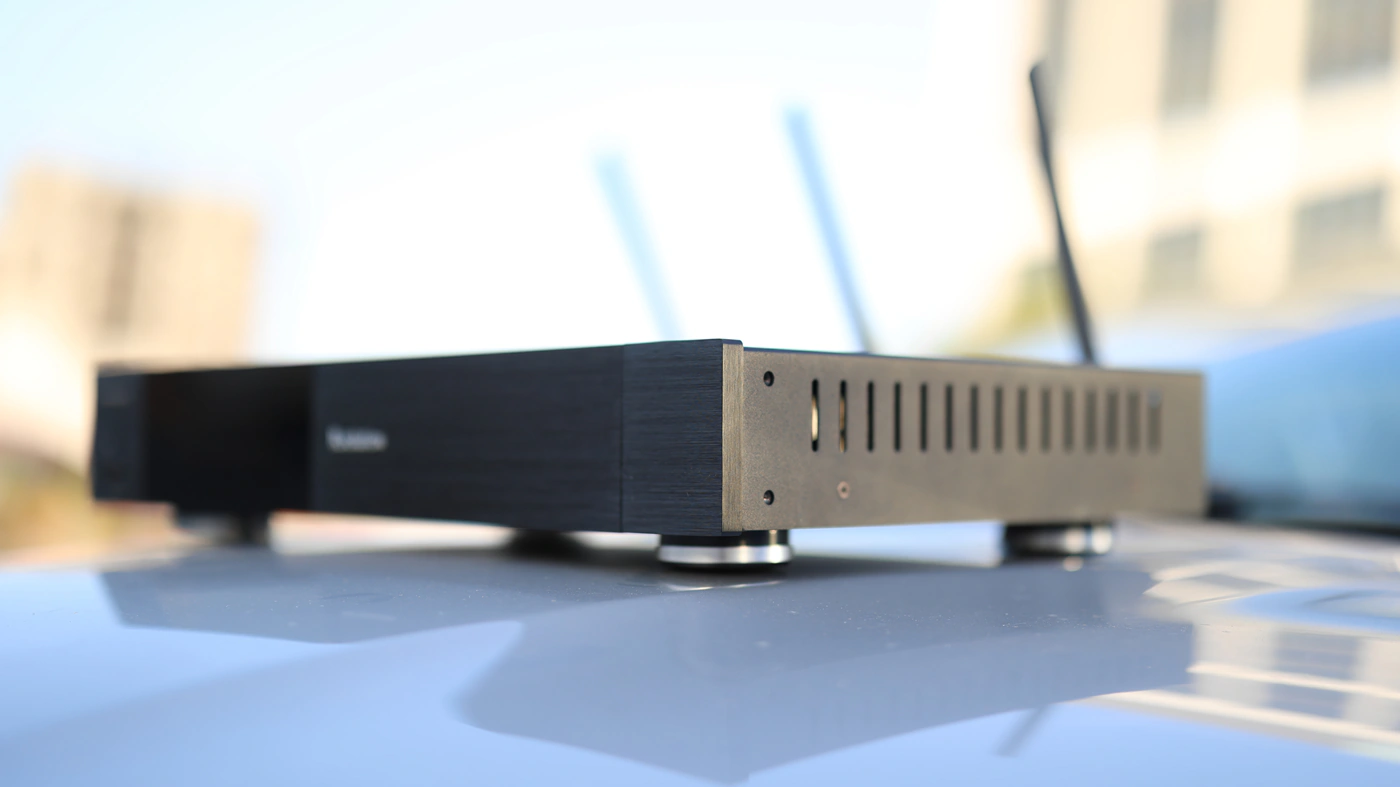
Naturally, Dolby Vision is a huge achievement to see on a player, as most Windows computers do not support either Dolby Vision or HDR10+, but PlayerOne 8K has VS10 video processing as well, so even if your monitor / TV does not support Dolby Vision, it can process the stream in a 12-Bit format to give you the full resolution and color range with no posterization effect despite a conversion being made on-the-fly. Both SDR and HDR content should be able to take advantage of the high-end processing available in PlayerOne 8K. And to add the most interesting part, we have AI Image Enhanced and AI Image Upscaler, similar to those found in madVR, which I keep recommend and using to this day, AI-PQ and AI-SR uses the power of AI do dynamically improve image quality, detail and edge sharpness while reducing video noise, extremely useful when upscaling 1080 content or even lower to 4K or 8K resolutions.
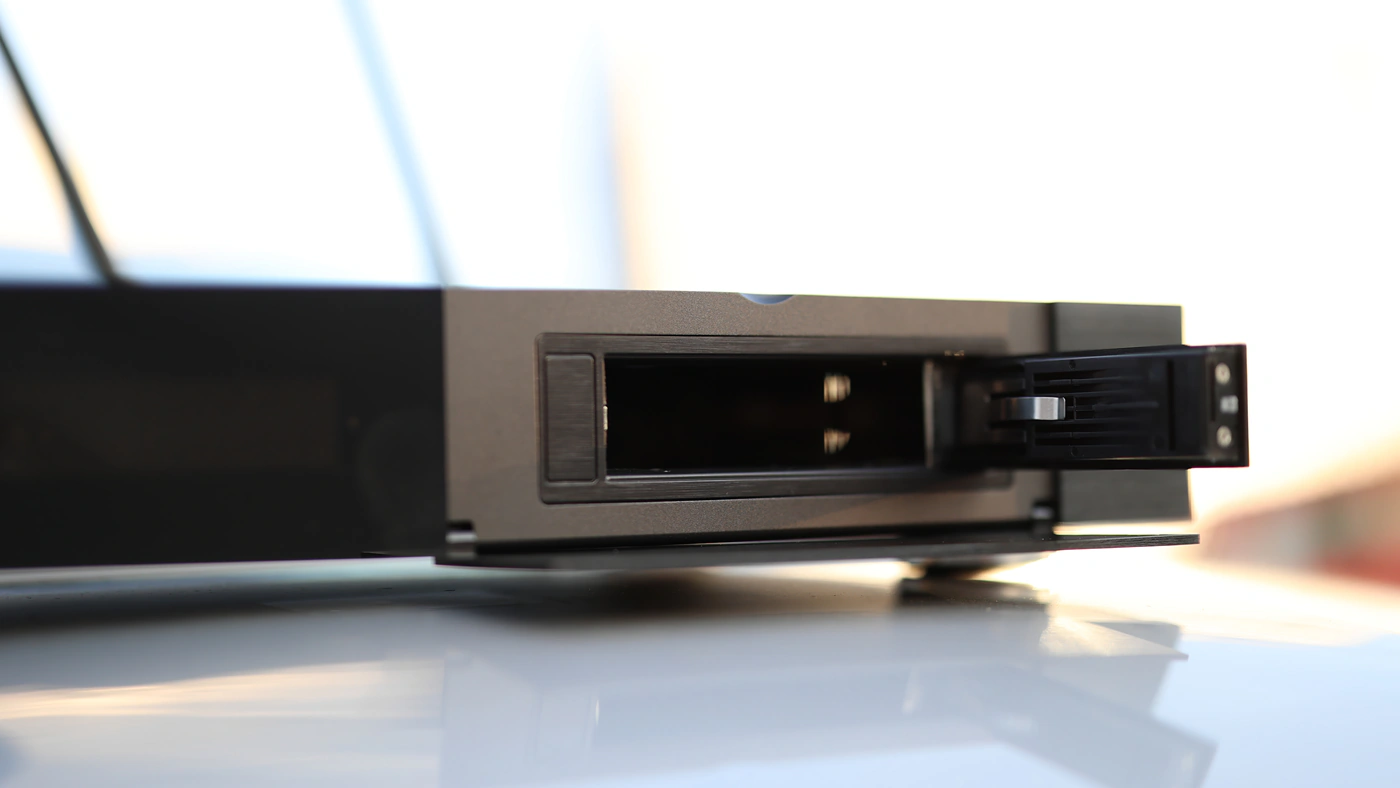
I actually do this on my computer too, as a lot of my video library is not available in 4K, and there are plenty of good movies never released in 4K, only available in DVD or FHD Blu Ray Formats. PlayerOne 8K takes things one step further, and imp[lements a high-quality switching power supply, specially calibrated for digital audio and video transport, to offer the best image quality, deep blacks and vibrant colors, with a high dynamic range and multi-channel sound reproduction. Thanks to the VS10 support, PlayerOne 8K can also upscale any SDR content to HDR on-the-fly, if your TV supports it.
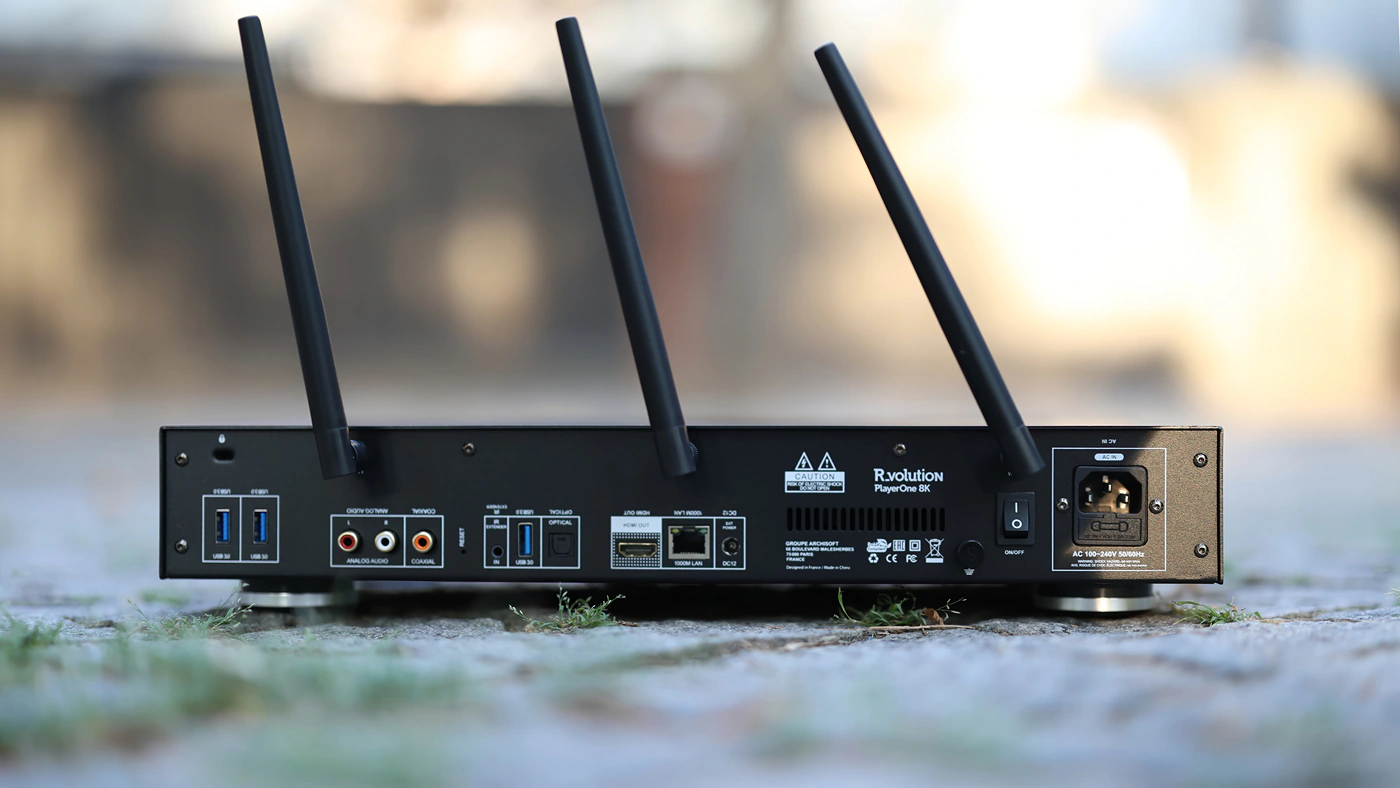
To allow you to store all your movie library, R Volution Player One 8K comes with a 3.5″ hot-swap HDD rack, which supports up to 32TB of data, or the equivalent of 800 Blu-Rays or 400 4K Ultra HD Blu-Rays, bit perfect. The best entertainment hub available on the market is included with the Player One 8K, and we have support for R_Video, which is much faster and more intuitive than the streamer app we typically see implemented in the audiophile world. To allow you the comfort of using Player One 8K without getting up from your couch, we have a high-quality BackLit Remote Controller. If you want to use a better power supply, PlayerOne 8K comes with a DC12V power input, and you can go for a power supply like those from Burson, or, as we will be testing, an Ultra Low Noise Power Supply like Keces P14.
Subjective Usage
Setting up the R_Volution PlayerOne 8K is simple and easy, it is very intuitive, if you’ve had a Media Player before, and although it is rather large, it looks beautiful and inserting a 3.5″ HDD is simple and fast. I was able to read an external HDD just fine, and it connects very quickly to a WiFi network and updates automatically. It has an extremely fast and reliably GUI and operating system and it makes me feel sorry for having to use old school streamers that move slowly, as it is so fluid and snappy.
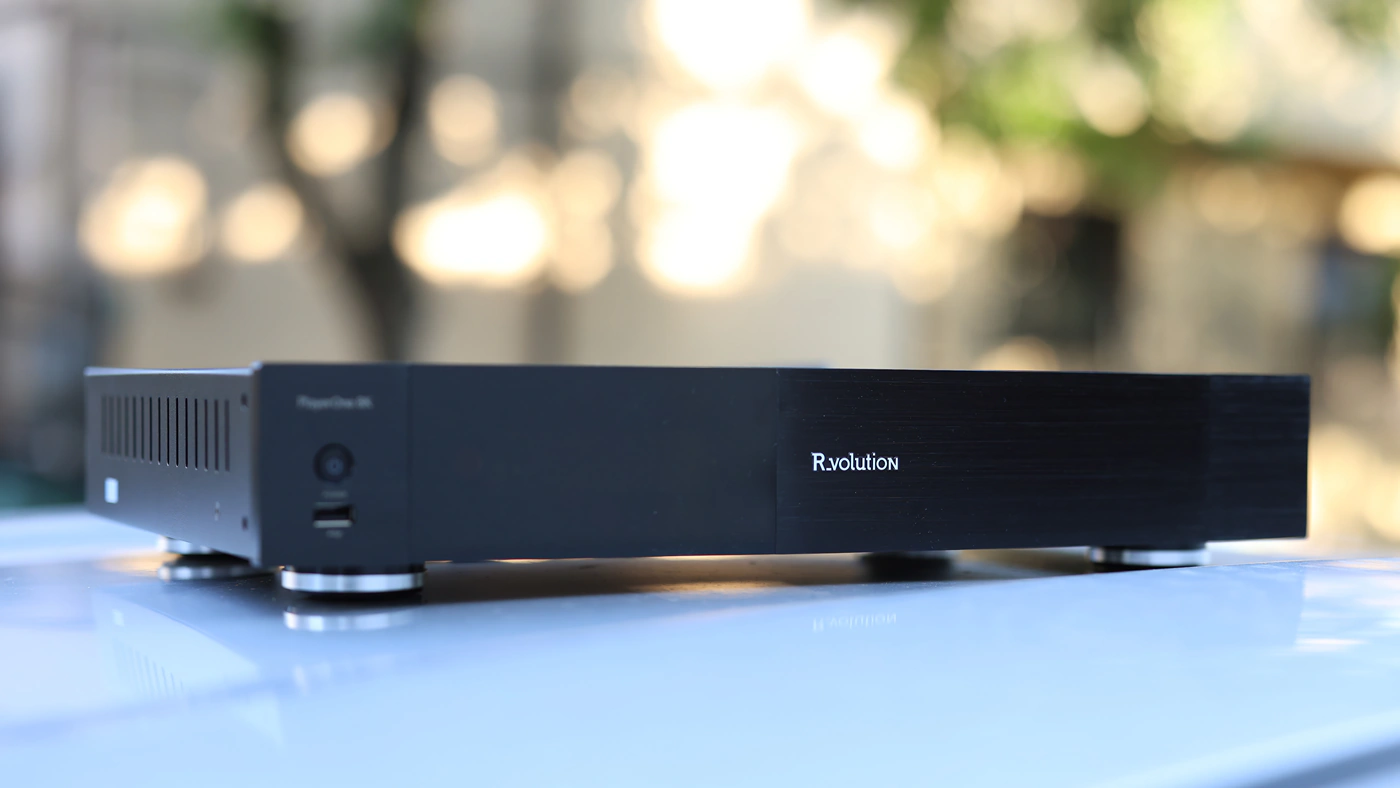
The way the operating system moves is quicker and more fluid than my computer which has an RTX4090 GPU and a 7950x and CPU. Windows is not a system optimized for fluidity and using player One 8K feels like the future is finally here. The list of supported apps is extensive and it includes Android TV, Google Play store, YouTube, Prime Video, Disney +, Kodi, Hiby Music, AirPin Pro, Miracast and Aptoide TV. You have the option to install most apps from Google play store, but I will be focusing more on YouTube and playing local files, as this is where the image quality will shine.
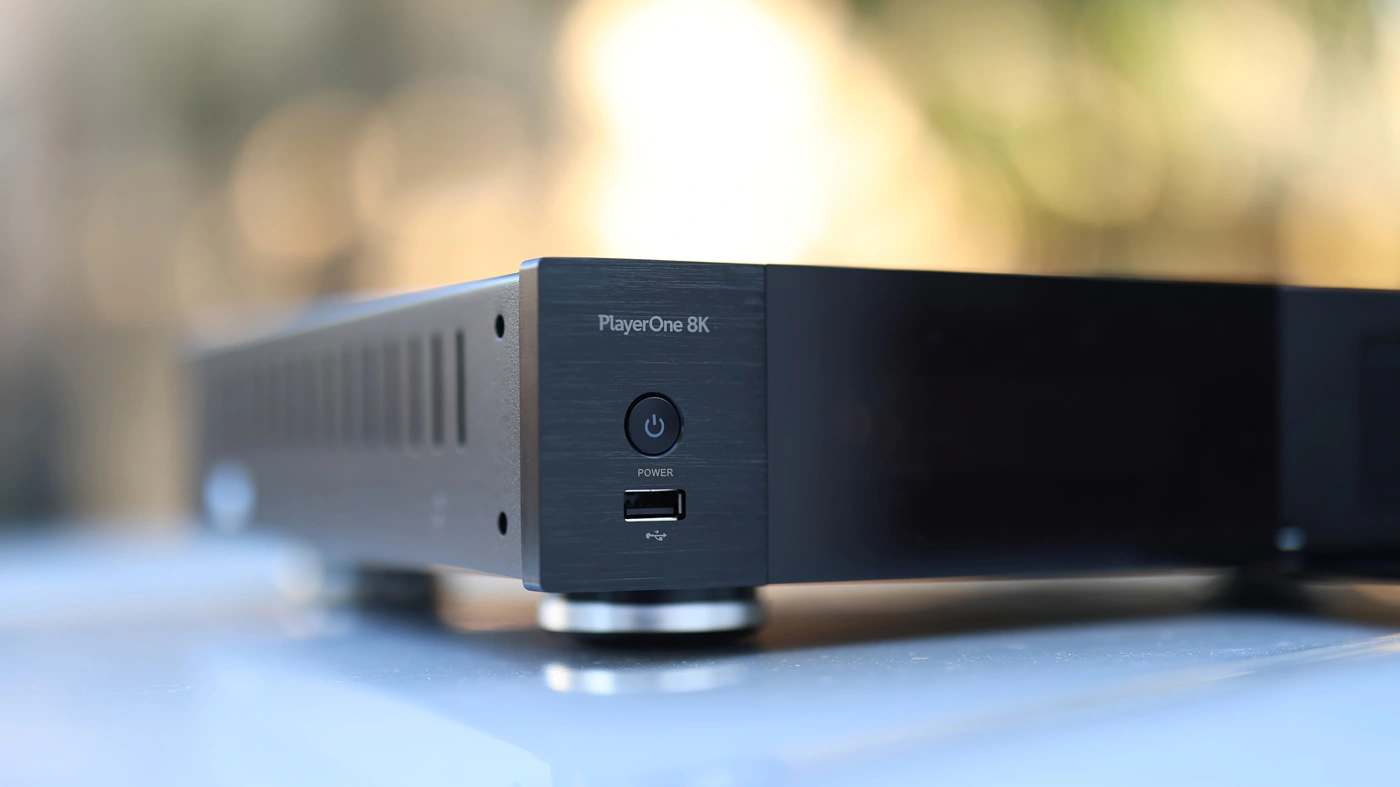
I can confirm that Player One 8k reads every single one of my video files, including raw camera files, and video files I have upscaled using Topaz Video Ai, as i got a few videos I really love and have upscaled to the point a single 5 minute video is around 5 GB, so it can read, decode and render videos of up to 1 GB per minute in true 4:4:4 data. This alone is one of the most amazing features that Player One 8K has. The sound is output via HDMi to the TV, which can further use an HDMI arc to output that sound to an external sound card.
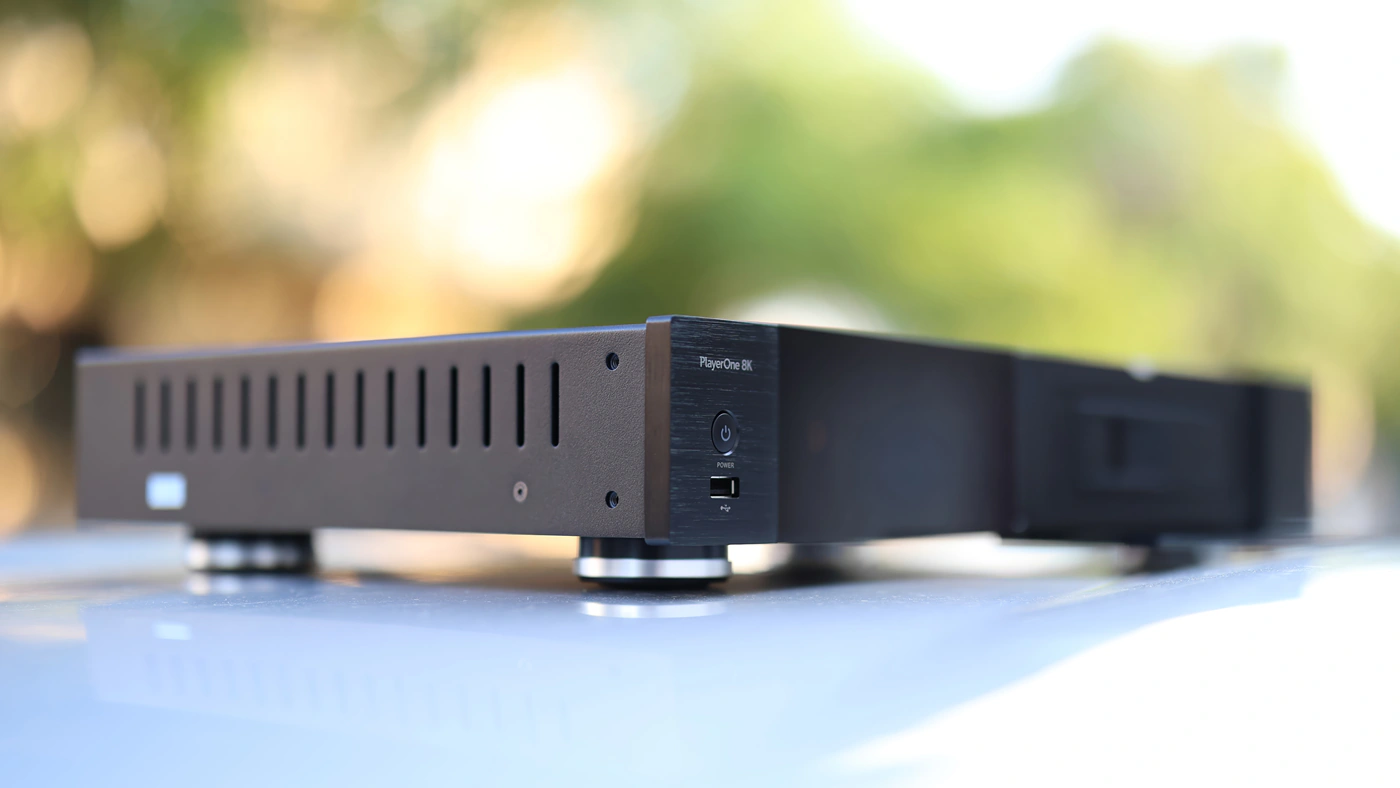
You can also use Player One 8K as a DAC to play music, and it can act both as a transport for an external dac via USB or via RCA for an external Amplifier. This function works not only very well but also automatically. The AI upscale algorithms are different from those implemented in madVR, and upon testing I am not sure which I’d say is better, madVR handles anime content better, but I configured it for it, and it needs rtx 4090 to upscale videos in real time at 4k , while PlayerOne 8K runs cool and renders real life content much better, with a more natural color and skin tone, being a better, more visually appealing solution.
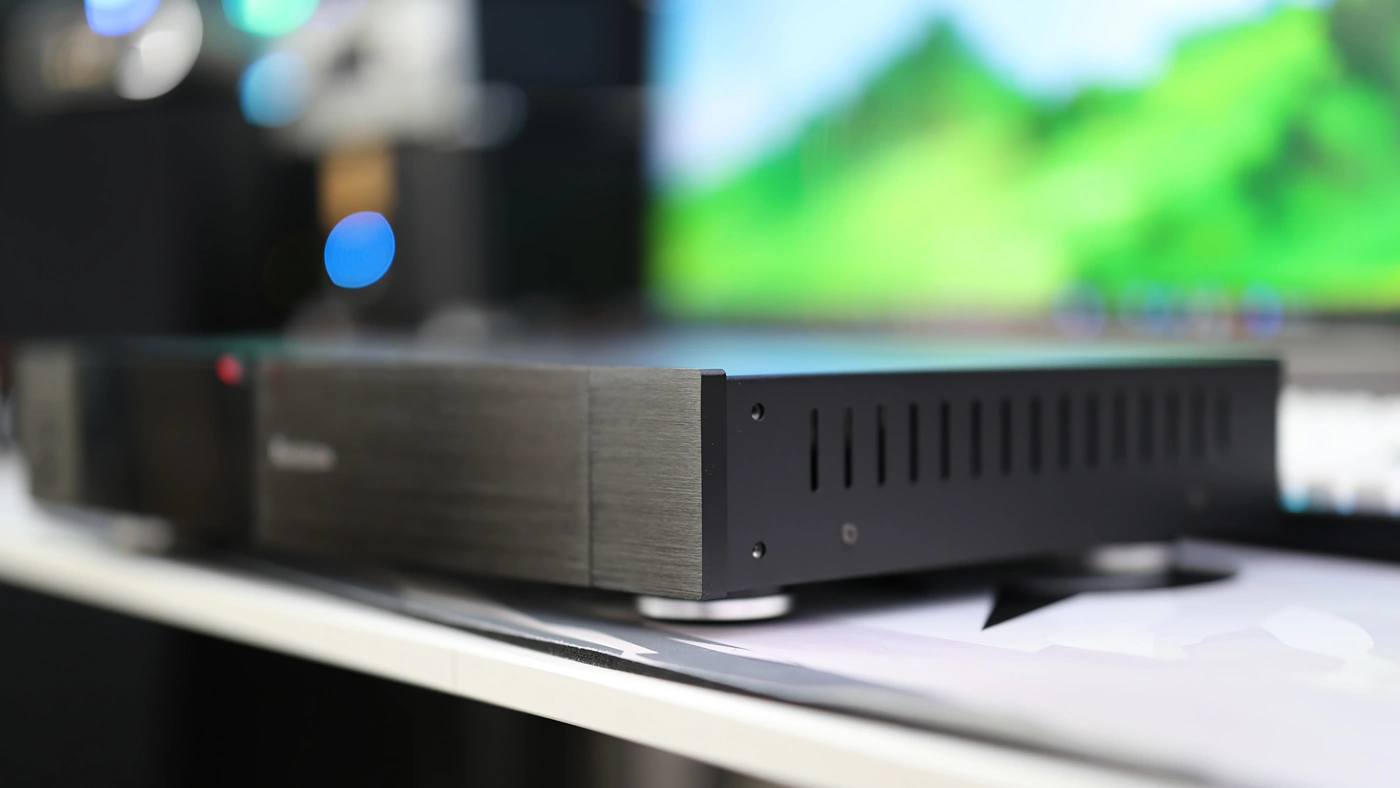
I noticed that R_Volution keeps insisting on how amazing the color is with their PlayerOne 8K and at first I was pretty hesitant, but visually, it is a stunning reproduction, with much better depth, clarity and sharpness than my computer, playing the very same files. Truth is, I disabled all HDR processing and Dolby Vision, so I’m basically rendering the same SDR files in SDR mode, which the vast majority of users have access to, and PlayerOne can actually render colors and details that no computer media player sees or renders.
Sound Quality / Image Quality
Pairings – To test the image quality, I have used the PlayerOne8K together with my Samsung 65QN95C QLED TV, while to test the sound quality, I have paired the R_Volution PlayerOne 8K with a multitude of DACs and AMPs, but most importantly Feliks Audio Euforia Evo driving a pair of Dan Clark Expanse, Fosi Audio V3 mono driving a pair of Audience ClairAudient 1+1 V5, and AIYIMA A70 Stereo amplifier to drive my trusty Pylon Audio Diamond 30 MKII speakers. PlayerOne8K also works to power a DAC, and it can use HDMI Arc, but using HDMI ARC depends more on your TV than on the PlayerOne. Everything is handled superb, and even if you output the digital signal to the TV, or if using PlayerOne 8K, you will always have the video and audio playback in real time. Everything is simply working together well, and I love this. For using PlayerOne as a DAC, via the RCA outputs, there is no background noise, and it even has a coaxial output, if your DAC has this input, having a very clean and detailed digital output there. To really test the PlayOne 8K, I have set my Samsung 65QN95C to Game Mode for all inputs, Brightness at 50, Contrast at 50, I have disabled local dimming, disabled Contrast Enhancer, Colour tone was set to Warm1, and Color Space to Native. Every other post processing has been disabled, so that we can see the most pure and raw output of the PlayerOne8K.
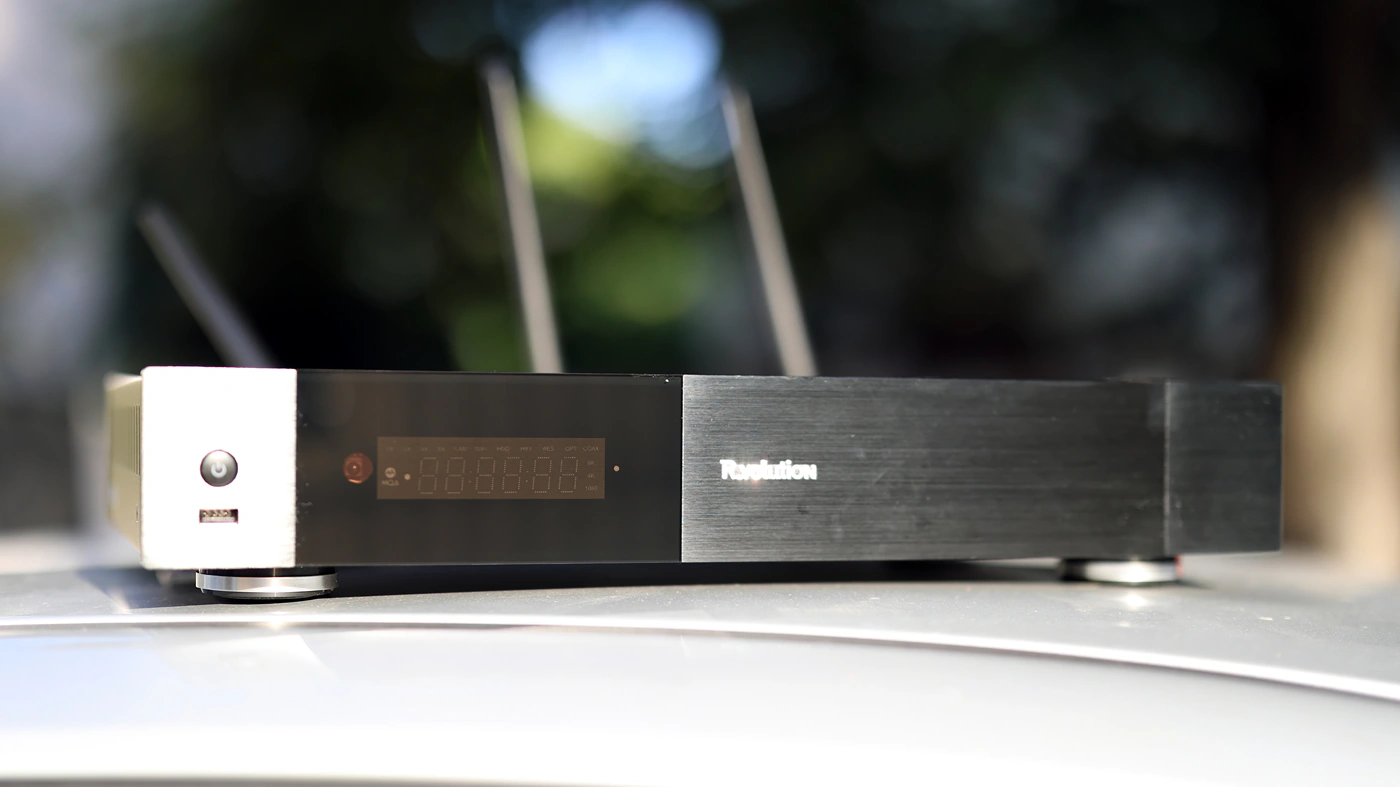
Overall Signature – PlayeROne8K has both its own visual signature and sonic signature, with the visual signature being the more relevant part for today’s review, and it is in one word colorful and detailed. I am able to use it both with the AI upscaling and refinement algorithms engaged and with them disabled and still have an excellent result that I enjoy, the AI upscaling effect, even when set at high, will not destroy the source content, but instead help refine small details and make everything clearer, with a genuine sharpening effect that considers the original material, texture, instead of being just a sharpening filter. You can engage in advanced debugging that tells you what the algorithms are doing, what they’re seeing and how they are being applied, and they are all optimized for real life content and not for anime or cartoons. This seems like an important fact for me, as an anime lover and game designer, but I am seeing such a crisp image when playing concerts that I think I can excuse this.
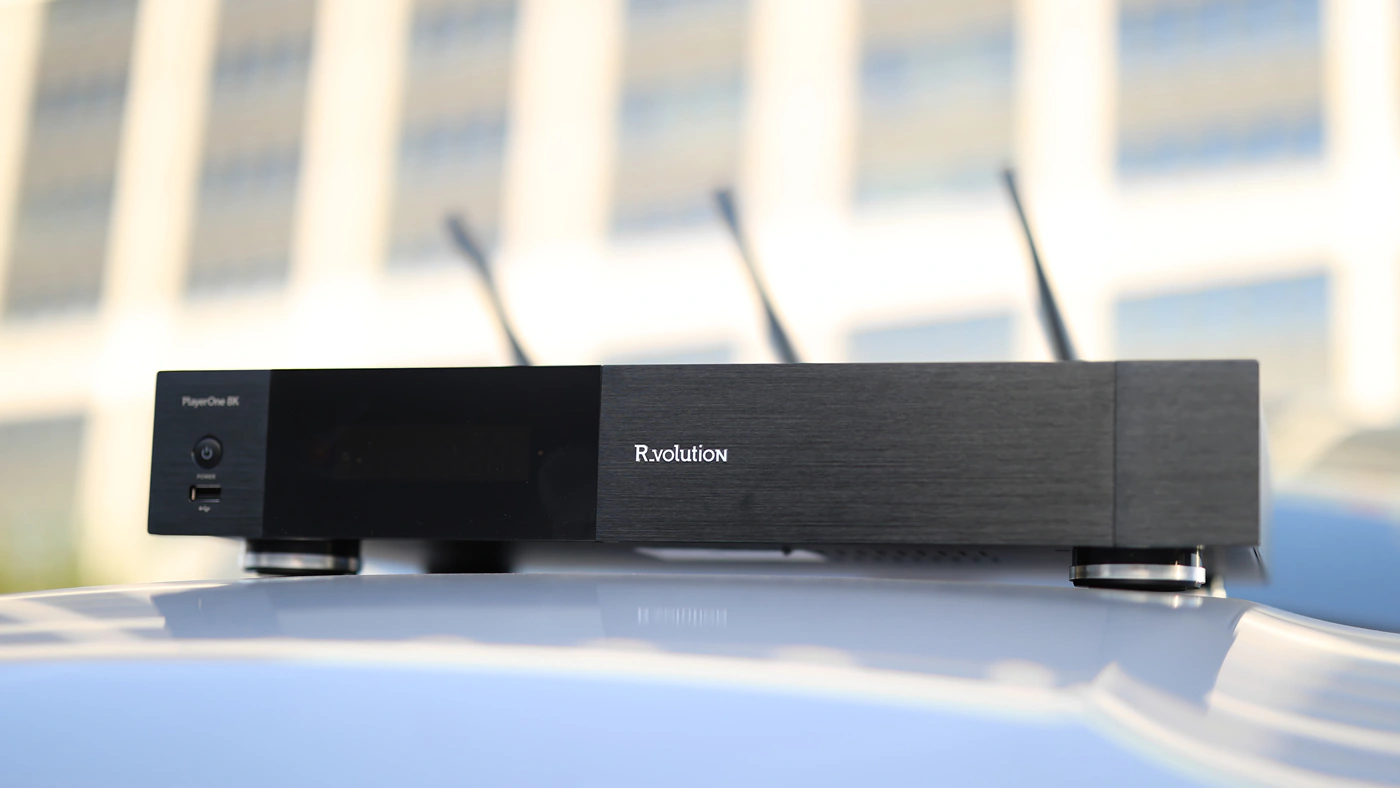
The general image is very colorful, contrasty and punchy, with a super vivid presentation and crisp image, having a beautiful presentation. I find the PlayerOne8K to be the most visually stunning media player I’ve tested to date, and I am using a powerful PC to watch content usually, yet it fails to deliver the same level of punchiness in the image, using the exact same video content. I was a bit afraid that PlayerOne8K would just be over-saturated, but it actually has a saturation gradient that is smoother, skin tones come through as more natural, textures on clothes, nature, foliage, everything just makes more sense and is more cohesive, it creates an image that’s cohesive and crisp, not over-saturated and exaggerated in any way. In fact, this is what I love the most about it, it looks natural and refined, like you’re watching movies and shows that were never digitally compressed and which were filmed at a higher resolution.
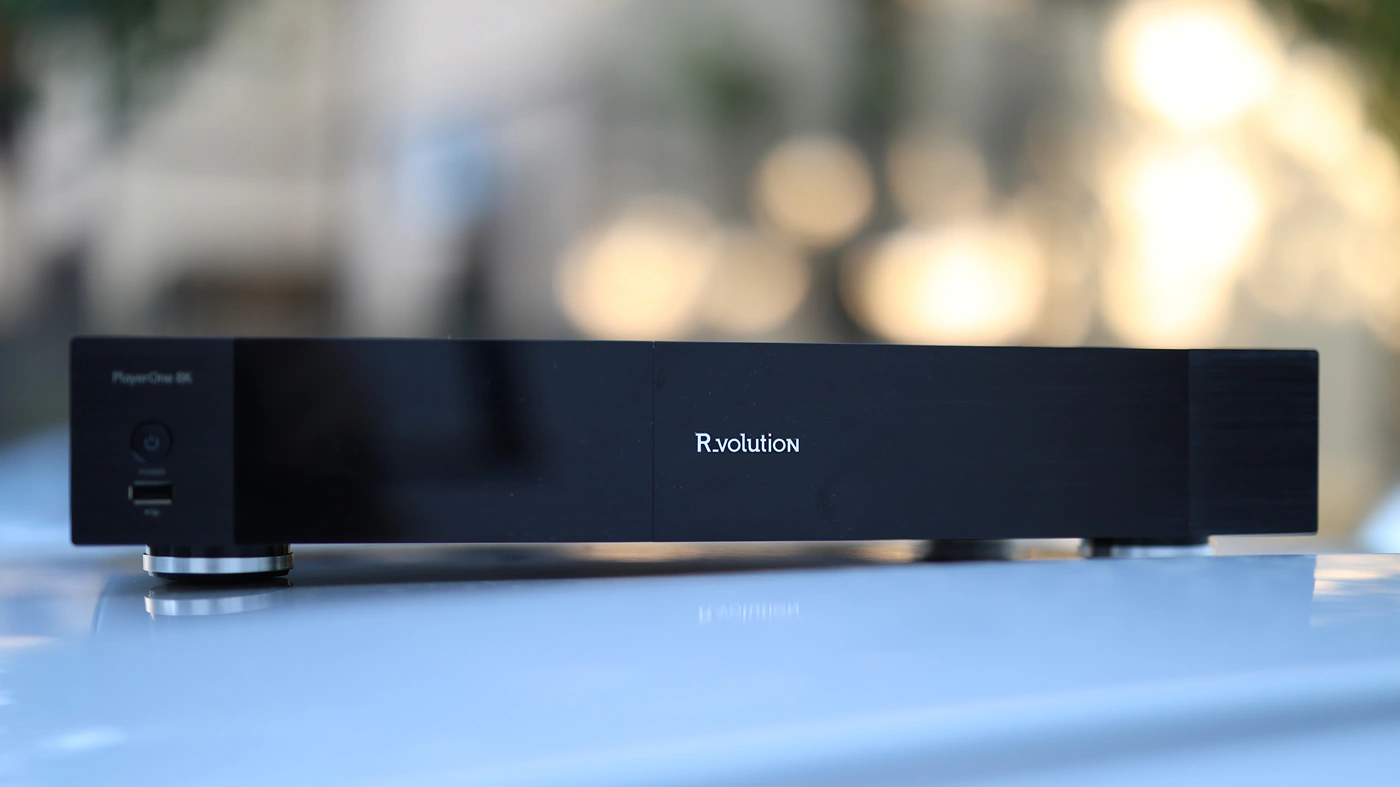
To give you some reference, the upscaling and processing found inside of my Samsung 65QN95C TV looks fake and exaggerated if I’m watching any kind of cable, while using madVR, I can get a better result, but I can never quite set things right, the image is either too sharp and looks fake, or too smooth and detail is lost, compared to PlayerOne8K which shows a much better definition and saturation to the information and details without exaggerating it. Playback also is less choppy, as PlayerOne8K can present 24 fps content, 30fps content and the notoriously hard to reproduce 23.98 fps content without any kind of frame drop. I am simply in love with how PlayerOne 8K handles large and high-resolution files, as it can totally play them without an issue, although I did notice that once you press pause, it allows the external and the internal HDD to rest, which causes the playback to take a few seconds when you resume, as the HDD is starting up.
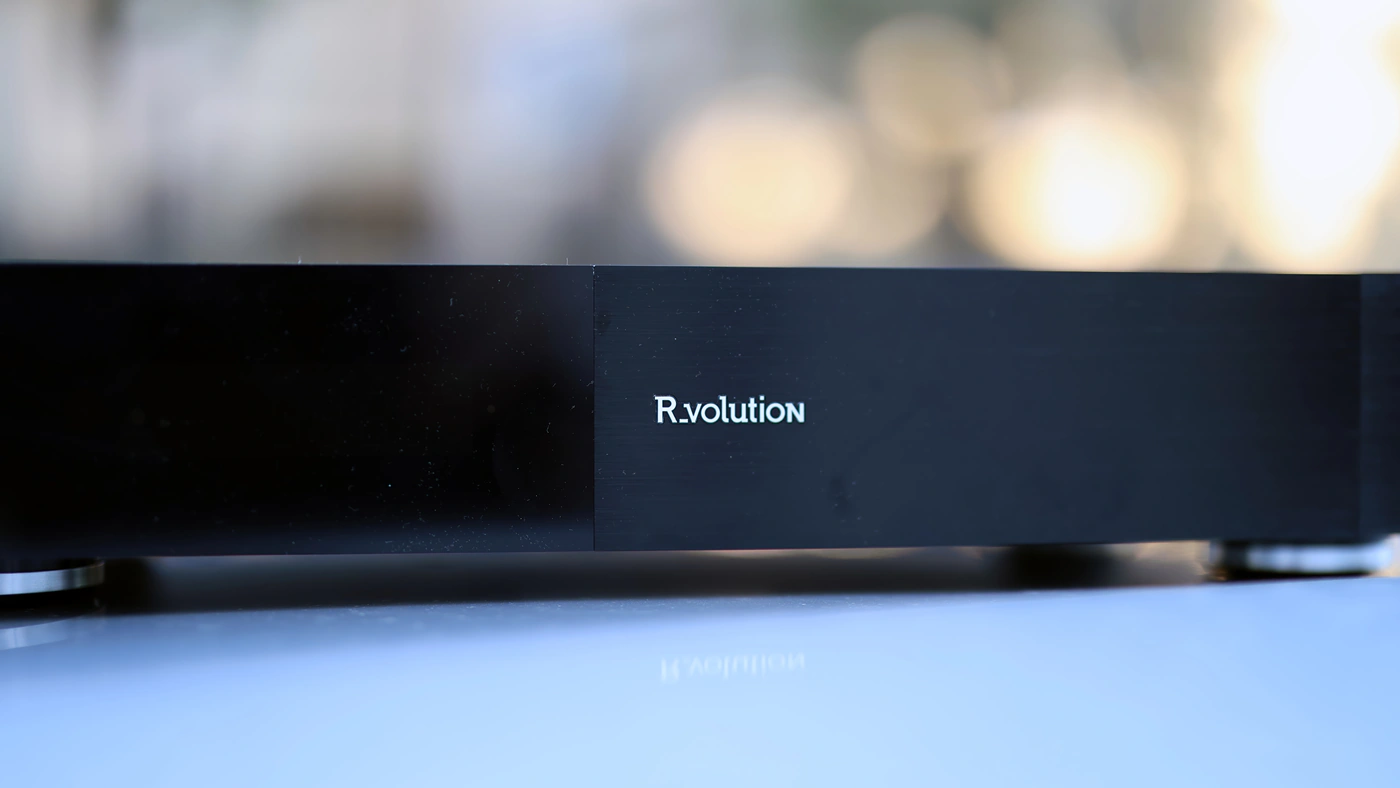
When you change files, you can set the PlayerOne8K to either always play the video at a constant frame rate and resolution, or change the resolution and frame rate for each video. Setting it to always change the resolution means that your TV will flicker a black screen as it is changing resolution, at least on all Samsung TVs, but there is no drawback to set it to 4K 120hz always so that playback is smoother and you don’t get this effect. Content which is recorded or processed for 4K 120fps works flawlessly, moves beautifully, and while most computers will struggle, or downright shut down when trying to play a 4K 120fps movie file, PlayerOne8K reacts like a champ.
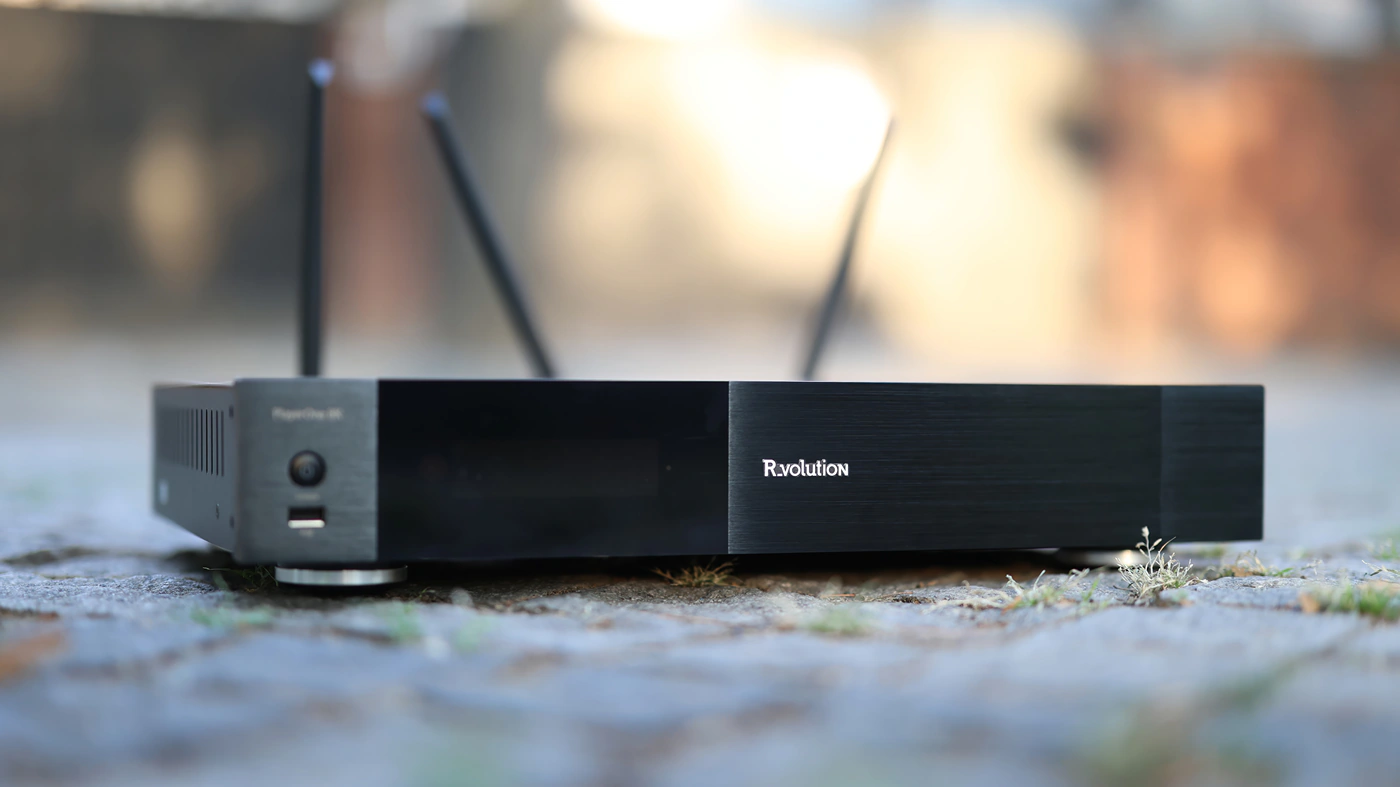
Loudness Saturation Gradient – This is an interesting thing, but PlayerOne8K has an internal volume, which is separate from the volume of the TV, but also separate from the volume of the Amplifier if you’re using an external Amplifier. I was able to use its 20-step volume with power amplifiers that do not have a PRE, and the loudness control is excellent, you get no artifacts and good control with a low distortion. This being said, from what I was able to determine, PlayerOne8K will output sound through all its outputs at the same time. This means that for example, if I have a pair of speakers and an amplifier connected via RCA, it will output sound to the TV as well, so I have to mute the TV using the TV’s remote, to allow sound to play just through the speakers. You can use this to your advantage if you want to play on more speakers at the same time.
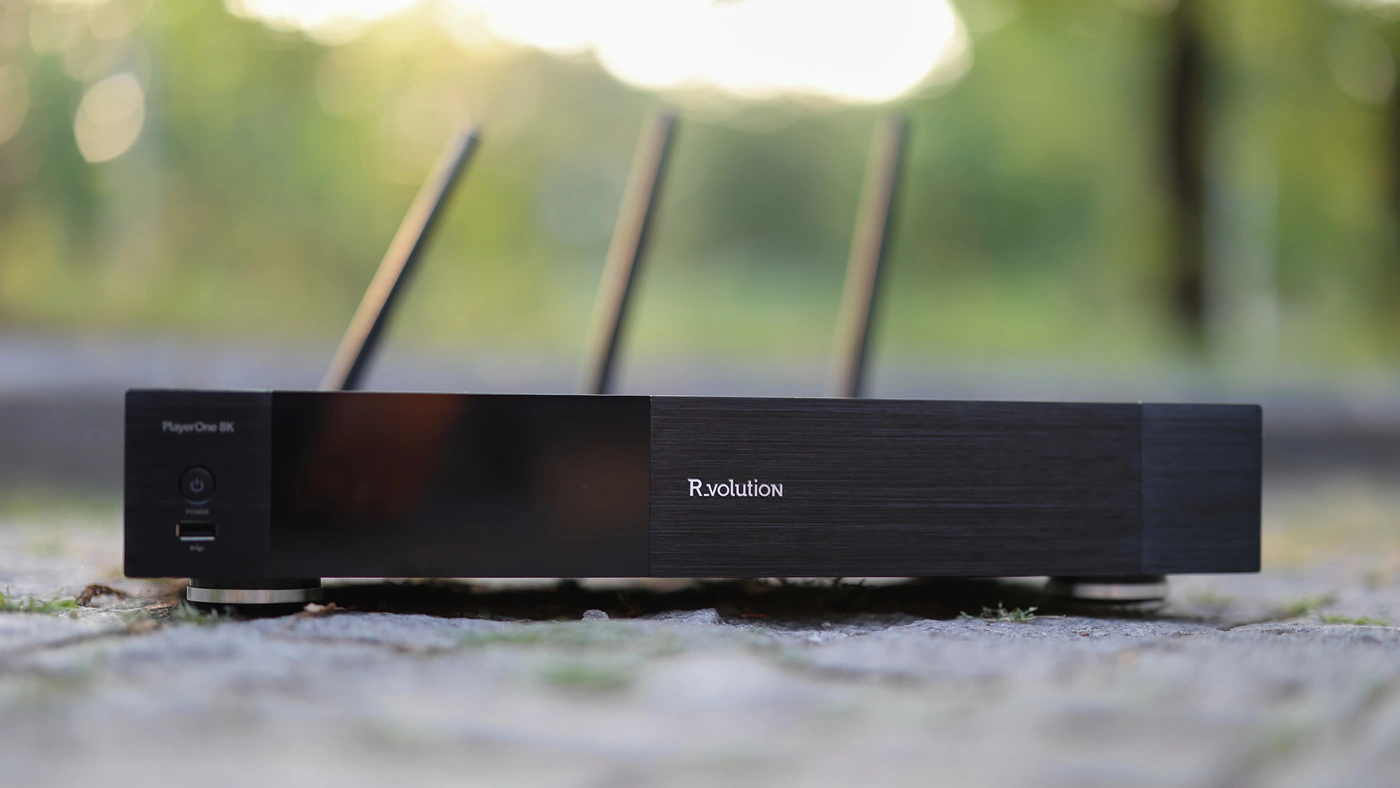
Dynamics Handling – The dynamic range of the image as well as of the sound played by PlayerOne8K is excellent, and it has both an amazing sound, but an even better image. The sound part of the PlayerOne seems to have been added for home theater enthusiasts as it projects a wide, holographic and punchy, vivid sound, but the image is even punchier, more vivid and more dynamic. Happily, with the 65QN95C having multiple HDMI inputs, I can quickly change between my PC and PlayerOne8K to check on how the image looks on each, and start / stop playback on each. PlayerOne8K seems to reproduce a higher depth of color, and a more vivid color, and regardless of how I configure the settings on my PC, I cannot get the TV to reproduce the same vibrant and punchy colors. The irony is that I can over-saturate the colors on the computer in many ways, but none cannot achieve the same level of depth and vibrancy / brightness of each color that the TV reproduces when it is being fed the signal from PlayerOne8K. This is most likely caused by a much better 4:4:4 chroma processing done by PlayerOne8K, as computers are notorious for easily breaking 4:4:4 reproduction, and also I’m seeing a pattern of more video being rendered and extracted from videos by PlayerOne8K compared to what either MPC-HC + madVR or VLC can reveal / render from the same video files. A much higher dynamic range on PlayerOne8K will be shown as a much more colorful and complex image.
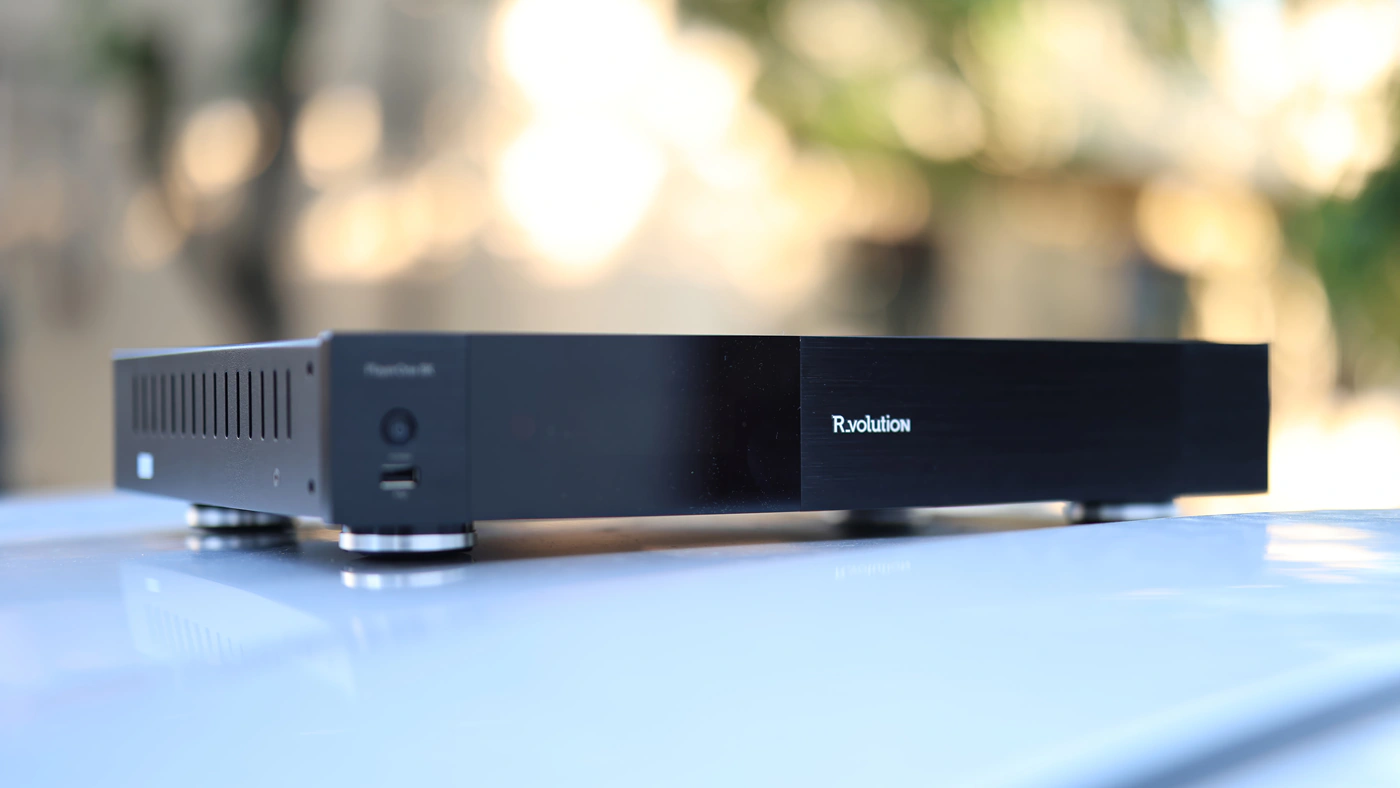
Textures – One of the things that a Media Player like PlayerOne8K handles best is textures, for example in clothes or walls, and other surfaces, which appear as smothered and smooth in my computer, but PlayerOne8K shows a much more natural image, with better depth, texture and more information. There’s no added grain or noise, and PlayerOne8K seems to reveal less grain in images and reveal more image, which is interesting, because any time I use a de-grain and de-noise in my computer, regardless of the software, it mutes details and cuts out information rendering textures too smooth and plain, while PlayerOne8K is able to render detailed, sharp textures, but with reduced grain and noise. Overall, the image is simply excellent and I can’t help but recommend PlayerOne 8K for its superb performance in every aspect, including and especially in how well the software works.
Value and Conclusion
For the price of $899 USD, PlayerOne 8K can deliver an image that’s far more stunning than a high-end PC computer with an RTX4090 GPU can deliver, and PlayerOne8K can read image files, music files, video files, any format, any framerate, and do it all snappy, quickly, and it can also organize your library and collection on the go, with complex upscaling and refinement algorithms that you can engage or disengage at will. The unit has an extremely high value, and if it is what you’re looking for and what you need, PlayerOne8K is literally a dream media player and should be at the top of your list, if not the most important device you will ever purchase and own for your home theater experience.
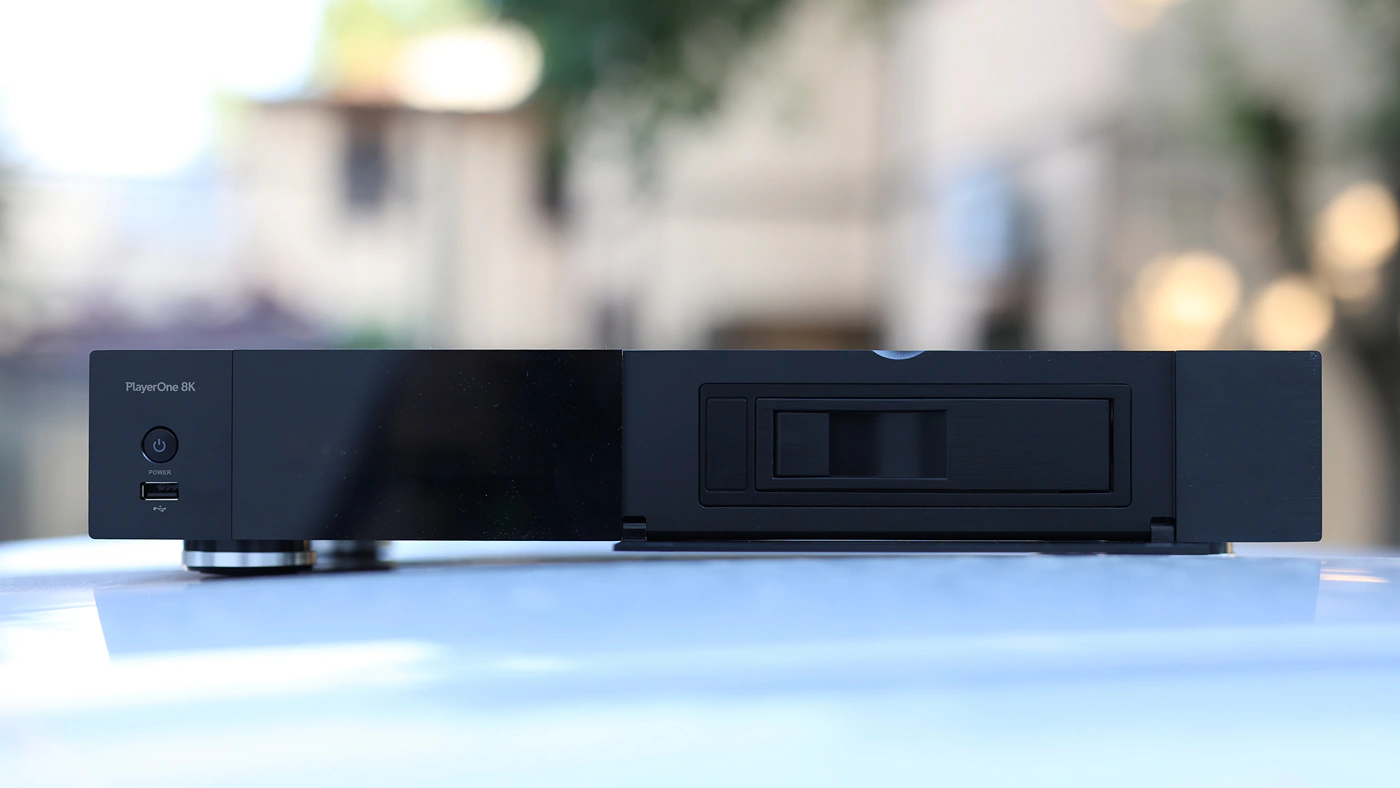
Before the end of the day, I want to add the R_Volution PlayerOne 8K to the Audiophile-Heaven Hall Of Fame, for its excellent and punchy image, vivid colors and strong processor, as it is able to play more files, handle a larger library and work better than the vast majority of media players, and I absolutely love the exceptional support for music playback, along the strong video playback. Everything about the PlayerOne8K works flawlessly, and it deserves to be cherished as a high-end top-of-the-line media player.
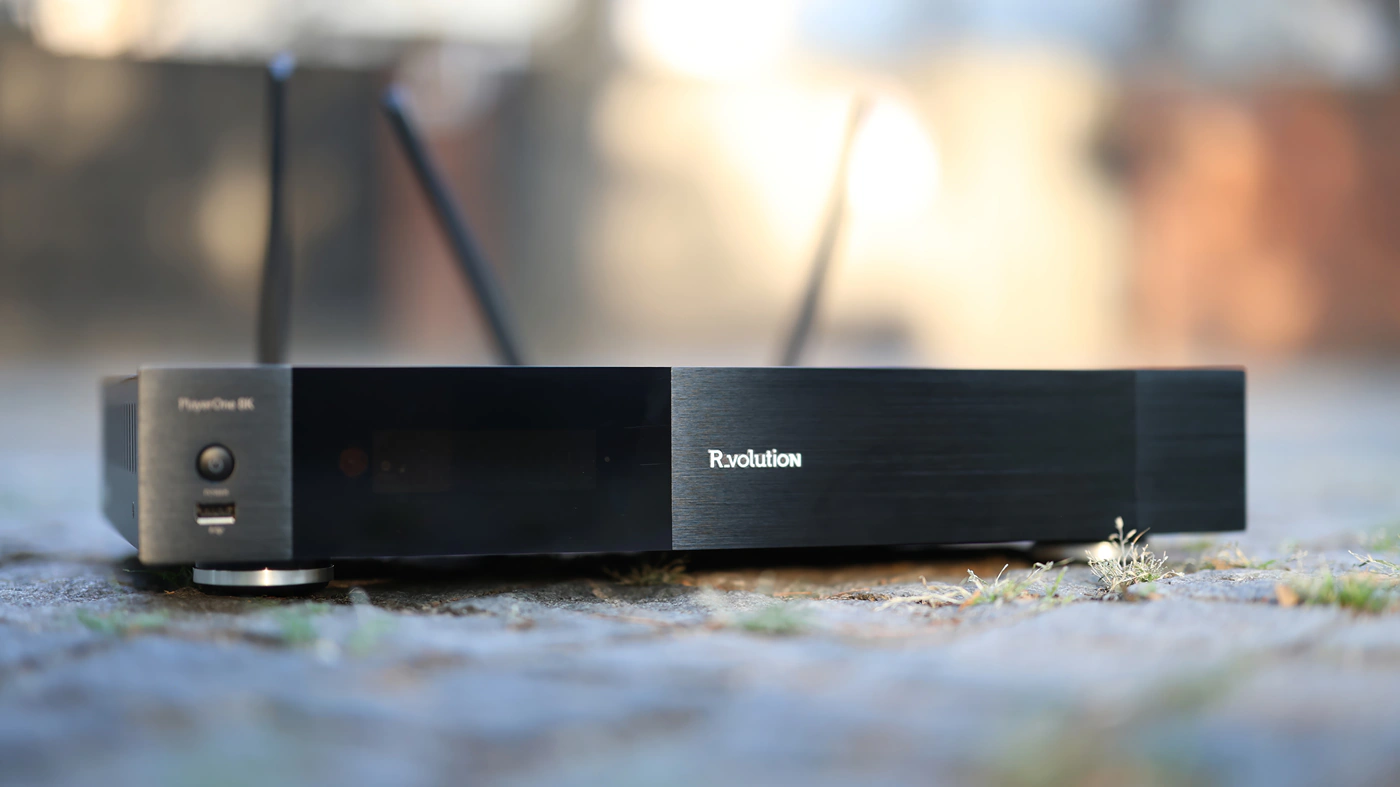
At the end of the day, the only regret I have about this review is not being able to take screenshots and photos of how beautiful the image PalyerOne8K can create, compared to what my PC computer can create, so that you can get a good idea of what an upgrade using PlayerOne8K can be compared to using a computer, even if we’re talking about SDR content only. For HDR Content, you have zero chance of a decent experience with Windows, while PlayerOne 8K handles HDR like it was born in it, everything works beautifully, so it is currently the most universal way to play your movies, videos, and media files losslessly and with a punchy, beautiful color.
Product Link
Official Link – https://rvolution.store/en/media-players/6272-rvolution-player-one-8k.html
Amazon – https://amzn.to/4eVnNeP
--- Please remember to stay safe, and always have fun while listening to music!---
- If you have a dime to spare, please donate, and help us! It would make the day brighter for me and my wife-
Full Playlist used for this review
We listened to more songs than those named in this playlist, but those are excellent for identifying a sonic signature. I recommend trying most of the songs from this playlist, especially if you’re searching for new music! The playlists are different for Spotify, Tidal and Youtube, and based on the songs I enjoy and are available on each!
https://www.youtube.com/playlist?list=PL_cjBXGmwSHSdGcwuc_bKbBDGHL4QvYBu
https://open.spotify.com/playlist/5J3oloz8Riy9LxEGenOjQ0?si=979ba4f082414be7
https://tidal.com/browse/playlist/330fd544-8e5b-4839-bd35-676b2edbb3d5
--- Contact Us ---





